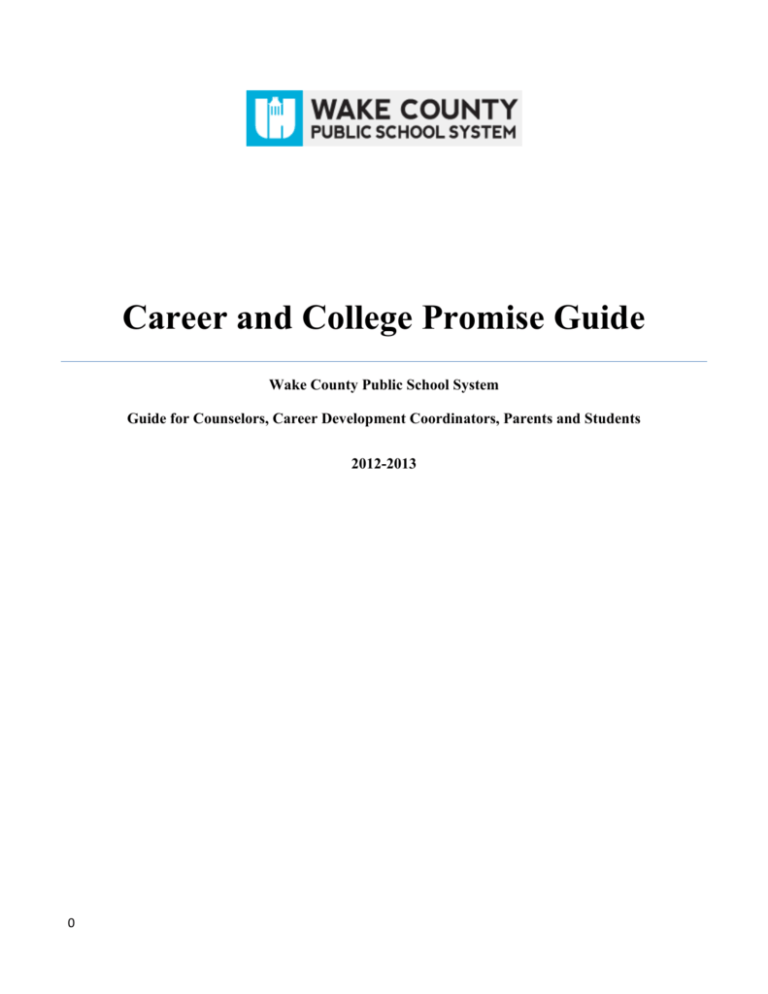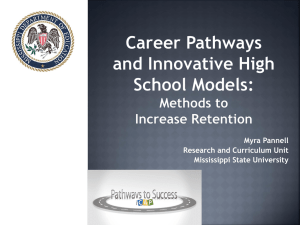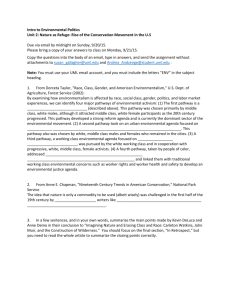Career and College Promise Guide
advertisement

Career and College Promise Guide
Wake County Public School System
Guide for Counselors, Career Development Coordinators, Parents and Students
2012-2013
0
Wake County Public School System Policy
5534
DUAL ENROLLMENT FOR ACADEMIC ENRICHMENT COURSES
5534
Middle and high school students may participate in dual enrollment to take approved courses at
institutions accredited by the Southern Association of Colleges and Schools or its regional equivalent
including Institutions of Higher Education (IHE) and North Carolina Virtual Public Schools (NCVPS),
while completing high school graduation requirements. Dual enrollment needs to be pursued with
thought and planning and requires written approval of parents and the principal prior to enrollment.
Graduation credits for academic enrichment courses taken within these accredited institutions will be
awarded, and grades will be used to calculate GPA for high-school students only if the requirements of
this policy are met. The superintendent/designee shall develop procedures for the implementation of this
policy.
5534 R&P DUAL ENROLLMENT FOR ACADEMIC ENRICHMENT COURSES 5534 R&P
A. Career and College Promise (High School)
The Career and College Promise (CCP) program offers qualified high school students structured dual
enrollment opportunities to earn both high school and community college credit through (1) a Career
and Technical Education Pathway or (2) a College Transfer Pathway. Career and College Promise works
in accordance with the North Carolina Community Colleges system, state law, and State Board policies.
For more information, refer to the Career and College Promise website (http://careercollegenc.org).
1. The parent or guardian of the high school student must give permission for the course to be
taken, and the student and parent/guardian must complete the dual enrollment form prior to
enrolling in the course. Enrollment of a student in a course is the responsibility of the student and
his/her parent or guardian.
2. The course must be approved in advance by the principal through the use of the dual enrollment
form. Prior to granting approval, the principal shall determine whether the course being taken is
eligible for credit toward graduation in accordance with the procedures and requirements
developed by the superintendent or designee.
3. Principals may approve a request for dual enrollment in a CCP Technical Career course even if
the course is available at the school.
4. The principal may grant permission for a dually enrolled student to attend classes at the IHE
during the regular school day.
5. Books, materials, and transportation required of the student are the responsibility of the student
and the parent or guardian. Students taking CCP courses are not required to pay tuition.
6. To receive credit towards high school graduation, the school from which the course is offered
must provide such essential information as is generally included in official transcripts of school
records. This information includes but not limited to:
1
a. a description of the content and subject matter covered by the course;
b. a syllabus from the course instructor that includes course goals, course objectives,
course activities, and grade requirements;
c. the student's achievement or performance level in the course.
7. Credit will not be awarded for office, teacher, or laboratory assistance.
8. High School graduation credits and grades will be awarded when the student presents evidence
from the IHE of successful completion of the course. Quality points will be calculated as defined
in the WCPSS High School Program Planning Guide.
9. At the end of each IHE quarter, semester, or summer school session, the student will be
responsible for providing the school with an official transcript as evidence of course completion.
10. A dually enrolled student taking a three to five (3-5) hour semester course or a quarter hour
equivalent and successfully completing the course requirements will receive one credit at the
school.
11. Grades for courses taken under dual enrollment will be used to calculate the Grade Point
Average (GPA) of the high school student.
12. The school will record the credit and grade on the student's official transcript.
13. Students enrolled at an IHE shall be subject to all of the established rules, regulations, and
calendar of that institution.
14. The dual enrollment of students during the summer is permitted with the permission of the parent
or guardian and the student's principal. Permission must be obtained prior to enrolling.
B. Other College Courses (High School)
Students wishing to enroll in courses taught by a college, university, or other institution of higher
education (IHE) must follow the guidelines for receiving course credit as established by the
superintendent or designee. Credit towards graduation shall be granted only for courses which are
consistent with policies and standards of the school district and State Board requirements, including the
requirements of the State Board policy GCS-M-001, 'Course for Credit.'
1. The parent or guardian of the high school student must give permission for the course to be
taken, and the student and parent/guardian must complete the dual enrollment form prior to
enrolling in the course. Enrollment of a student in a course is the responsibility of the student and
his/her parent or guardian.
2. The course must be approved in advance by the principal through the use of the dual enrollment
form. Prior to granting approval, the principal shall determine whether the course being taken is
eligible for credit toward graduation in accordance with the procedures and requirements
developed by the superintendent or designee.
2
3. Principals shall only approve requests to enroll in outside institutions and entities if:
a. the course is not available or cannot be scheduled at the student's school;
b. the student's participation in the course does not in any manner conflict with his or
her enrollment/participation in required courses at his or her school;
c. the course is not required by the State Board of Education to be taken at a public
school.
4. The principal may grant permission for a dually enrolled student to attend classes at the IHE
during the regular school day.
5. Each course provider must be accredited by the Southern Association of Colleges and Schools or
its regional equivalent.
6. Fees, charges, tuition, books, materials, and transportation required of the student are the
responsibility of the student and the parent or guardian.
7. To receive credit towards high school graduation, the school from which the course is offered
must provide such essential information as is generally included in official transcripts of school
records. This information includes but not limited to:
a. a description of the content and subject matter covered by the course;
b. a syllabus from the course instructor that includes course goals, course objectives,
course activities, and grade requirements;
c. the student's achievement or performance level in the course.
8. Credit will not be awarded for office, teacher, or laboratory assistance.
9. High School graduation credits and grades will be awarded when the student presents evidence
from the IHE of successful completion of the course. Quality points will be calculated on as
defined in the WCPSS High School Program Planning Guide.
10. At the end of each IHE quarter, semester, or summer school session, the student will be
responsible for providing the school with an official transcript as evidence of course completion.
11. A dually enrolled student taking a three to five (3-5) hour semester course or a quarter hour
equivalent and successfully completing the course requirements will receive one credit at the
school.
12. Grades for courses taken under dual enrollment will be used to calculate the Grade Point
Average (GPA) of the high school student.
13. The school will record the credit and grade on the student's official transcript.
14. Students enrolled at an IHE shall be subject to all of the established rules, regulations, and
calendar of that institution.
3
15. The dual enrollment of students during the summer is permitted with the permission of the parent
or guardian and the student's principal. Permission must be obtained prior to enrolling.
C. E-Learning/NC Virtual Public Schools (Middle/High School)
The North Carolina Department of Public Instruction, in partnership with North Carolina's Distance
Learning System, North Carolina Virtual Public School (NCVPS), Local Education Agencies (LEA),
and the UNC System gives public school students the opportunity to take a wide array of online courses
outside the normal school day or during the school day. Participation in these programs requires the
completion of the dual enrollment form and principal's approval. Students may also take individualized
elearning courses that meet State Board requirements and district policies for course credit and is from
one of the accredited institutions.
1. The superintendent or designee may develop additional procedures and requirements consistent
with State Board requirements and local policy for students enrolling in a NCVPS course
available through the University of North Carolina system and/or community colleges.
2. Students must be currently enrolled in a WCPSS middle or high school.
3. As NCVPS's courses are made available, they will be provided at no cost to the WCPSS student
or the student's parent or guardian. Due to budgetary restraints schools may request that parents
purchase any required textbooks that are not available online or readily available in their
building. Any additional resources (such as digital cameras, handheld devices, MIDIs, etc.)
required by the instructor of the online course are the sole responsibility of the student.
4. E-learning courses must meet the State and local board requirements to qualify for course credit.
Enrolling in an e-learning course for credit will count toward satisfying local board requirements
related to minimum instructional days, seat time policies, student attendance, athletics and/or
extracurricular obligations.
5. E-learning courses offering instruction in courses included with the NC Standard Course of
Study must meet the Standard Course of Study competency goals and objectives. E-Learning
courses offered for Advanced Placement or International Baccalaureate credit must align with
nationally validated standards for AP and IB, where available.
6. Where required, end-of-course tests and post assessments must be used as an indicator of student
mastery. The student's school schedules and administers EOC tests. These scores shall be
included in the determination of the school's accountability model.
Revised: August 21, 2012
Adopted: June 17, 1991
Revised: March 17, 1997
Revised: October 23, 2000
4
Career and College Promise Program
I.
Overview
Session Law 2011-145, the Appropriations Act of 2011, authorized the State Board of Education and
the State Board of Community Colleges to establish the Career and College Promise program, effective
January 1, 2012. The purpose of Career and College Promise is to offer structured opportunities for
qualified high school students to dually enroll in community college courses that provide pathways that
lead to a certificate, diploma, or degree as well as provide entry-level jobs skills.
Career and College Promise offers North Carolina high school students a clear path to success in college
or in a career. The program is free to all students who maintain a “B” average and meet other eligibility
requirements. Through a partnership of the Department of Public Instruction, the N.C. Community
College System, the University of North Carolina system and many independent colleges and
universities, North Carolina is helping eligible high school students to begin earning college credit at a
community college campus at no cost to them or their families. The three pathways include:
1. Core 44 College Transfer Pathways (CTP) requires the completion of at least 30 semester hours
of transfer courses including English and mathematics.
2. Career and Technical Education Pathways (CTE) lead to a certificate or diploma aligned with a
high school career cluster.
3. Cooperative Innovative High School Programs (CIHSP) are located on college campuses (unless
a waiver was provided) and provide opportunities for students to complete an associate degree
program or earn up to two years of college credit within five years. Examples include Early and
Middle College High Schools
The Career and College Promise guide is governed by WCPSS Board policies which in turn are
governed by the North Carolina Department of Public Education board policies which are subject to
change. Placement of individual students in courses is subject to the availability of open seats at Wake
Technical Community College.
Pathway Eligibility Requirements
Core 44 College Transfer Pathway
College Transfer Pathways Definition
Students enrolled in the College Transfer Pathways receive tuition free course credits toward a four-year
degree. The Core 44 Pathway provides 30 to 34 SHC (Semester Hours Credit) leading to the 44 hour
general education core.
1. The Career and College Promise Core 44 College Transfer Pathway requires the completion of at
least thirty semester hours of transfer courses, including English and mathematics.
2. To be eligible for enrollment, a high school student must meet the following criteria:
a. Be a high school junior or senior;
5
b. Have a weighted GPA of 3.0 on high school courses; and
c. Demonstrate college readiness on an assessment or placement test (see attachment A). A
student must demonstrate college readiness in English, reading and mathematics to be
eligible for enrollment in a Core 44 College Transfer Pathway.
3. A high school junior or senior who does not demonstrate college-readiness on an approved
assessment or placement test may be provisionally enrolled in a College Transfer Pathway. To
qualify for Provisional Status, a student must meet the following criteria:
a. Have a cumulative weighted GPA of 3.5;
b. Have completed two years of high school English with a grade of ‘C’ or higher;
c. Have completed high school Algebra II (or a higher level math class) with a grade of ‘C’
of higher;
d. Obtain the written approval of the high school principal or his/her designee; and,
e. Obtain the written approval of the community college president or his/her designee.
A Provisional Status student may register only for college mathematics (MAT) and college English
(ENG) courses within the chosen Pathway. To be eligible to register for other courses in the
Pathway, the student must first successfully complete mathematics and English courses with a grade
of ‘C’ or higher.
4. To maintain eligibility for continued enrollment, a student must
a. Continue to make progress toward high school graduation, and
b. Maintain a 2.0 GPA in college coursework after completing two courses.
5. A student must enroll in one Core 44 College Transfer Pathway program of study and may not
substitute courses in one program for courses in another.
6. A student may change his or her program of study major with approval of the high school
principal or his/her designee and the college’s chief student development administrator. \
7. With approval of the high school principal or his/her designee and the college’s chief student
development administrator, a student who completes a Core 44 College Transfer Pathway while
still enrolled in high school may continue to earn college transfer credits leading to the
completion of the 44-hour general education transfer core.
8. With approval of the high school principal or his/her designee and the college’s chief student
development administrator, a student may enroll in both a Core 44 College Transfer Pathway
program of study and a Career Technical Education program of study.
9. Currently enrolled high school students who have successfully completed a college transfer
STEM course with a grade of “C” or better may be admitted into a Career and College Promise
College Core 44 Transfer Pathway without meeting the entry GPA or testing requirements (i.e.
PLAN). Students will be required to meet course prerequisite requirements.
6
Dual Enrollment Credit for College Transfer Pathway
Students participating in the Career & College Promise program College Transfer Pathway may earn
high school credit for successfully completing college courses ('dual credit') according to the Career &
College Promise program guidelines established by the Department of Public Instruction. For more
information view Attachment G.
Pathway Eligibility Requirements
Career Technical Education Pathway
Career Technical Education Pathways Definition
Students enrolled in the College Technical Education Pathway Program receive tuition free course
credits toward an entry level job credential, certificate or diploma for eligible high school students.
1. The Career and College Promise Career Technical Education Pathway leads to a certificate or
diploma aligned with a high school Career Cluster.
2. To be eligible for enrollment, a high school student must meet the following criteria:
a. Be a high school junior or senior;
b. Have a weighted GPA of 3.0 on high school courses or have the recommendation of the
high school principal or his/her designee; and
c. Meet the prerequisites for the career pathway.
3. High school counselors should consider students’ PLAN scores in making pathway
recommendations.
4. College Career Technical Education courses may be used to provide partial or full fulfillment of
a four-unit career cluster. Where possible, students should be granted articulated credit based on
the local or state North Carolina High School to Community College articulation agreement
(https://www.google.com/url?q=http://www.nccommunitycolleges.edu/Perkins/2011%2520HS%
2520Articulation%2520Agreement%2520v.11.1.11a%5B1%5D.docx&sa=U&ei=gS3SUNn5MbQ2wXhn4GQBw&ved=0CAoQFjAB&client=internal-udscse&usg=AFQjCNGosNSyCAvHJVC-mNPa6KjtPlU4Tw).
5. To maintain eligibility for continued enrollment, a student must
a. Continue to make progress toward high school graduation, and
b. Maintain a 2.0 in college coursework after completing two courses.
6. A student must enroll in one program of study and may not substitute courses in one program for
courses in another. The student may change his or her program of study major with approval of
the high school principal or his/her designee and the college’s chief student development
administrator.
7
7. Currently enrolled high school students who have successfully completed a community college
technical education course with a grade of “C” or better may be admitted into a Career and
College Promise Career Technical Education Certificate Pathway without meeting the entry
GPA or testing requirements (i.e. PLAN). Students will be required to meet course prerequisite
requirements.
Pathway Eligibility Requirements
Cooperative Innovative High School Programs (CIHSP)
Cooperative Innovative High School Programs Definition
The CIHSP leads to the completion of a high school diploma and associate degree program or provides
up to two years of college credit within five years.
1. Cooperative Innovative High School Programs are located on college campuses, enroll 100 or
fewer students per grade level, and provide opportunities for students to complete an associate
degree program or earn up to two years of college credit within five years are defined as
Cooperative Innovative High School Programs.
2. Eligibility requirements for Cooperative Innovative High School Programs are established jointly
by local boards of education and local boards of trustees in accordance with G.S. 115C-238.50.
3. The State Board of Education and the State Board of Community Colleges may waive the
requirement that a Cooperative Innovative High School Program is located on the community
college campus.
Student Application Process
1. The high school will document eligibility criteria (high school GPA and PLAN or other
assessment scores) on the student’s transcript. (See Attachment A: Test Scores)
2. Students must complete a college application to be admitted into a Career and College Promise
pathway. (See Attachment B: Wake Technical Community College Admissions Application and
Wake Technical Community College Career and College Promise (CCP) Eligibility Verification
(EV) Form)
Notes:
Attachment C provides an overview of the Career and College Promise pathways offered.
Attachment D provides details of the Core 44 College Transfer Pathway.
Attachment E provides details of the Career and Technical Education (CTE) Transfer Pathway.
Attachment F is provided as a Wake Technical Community College Career and College Promise
Program Quick Reference.
Attachment G provides details on the Dual Credit for Career and College Promise
Wake Technical Community College/Career and College Promise Course Descriptions:
http://catalog.waketech.edu/9courselisting/
8
0
Attachment B
WTCC Admissions Application
1
Attachment B
WTCC Admissions Application
2
Attachment B
WTCC Admissions Application
3
Attachment B
WTCC Admissions Application
4
Attachment B
WTCC Admissions Application
5
Attachment B
CCP Application
6
Attachment B
CCP Application
7
Attachment C
Overview of CCP Pathways
8
Attachment D
Core 44 College Transfer Pathway
9
Attachment D
Core 44 College Transfer Pathway
10
Attachment D
Core 44 College Transfer Pathway
11
Attachment D
Core 44 College Transfer Pathway
12
Attachment E
CTE Transfer Pathway
13
Attachment E
CTE Transfer Pathway
14
Attachment E
CTE Transfer Pathway
15
Attachment E
CTE Transfer Pathway
16
Attachment E
CTE Transfer Pathway
17
Attachment E
CTE Transfer Pathway
18
Attachment E
CTE Transfer Pathway
19
Attachment F
WTCC and CCP Program Quick Reference
20
Attachment G
Dual Credit Update Memo From NC DPI
21
Attachment G
Dual Credit for Career & College Promise
22
Attachment G
Dual Credit for Career & College Promise
23


![Major Change to a Course or Pathway [DOCX 31.06KB]](http://s3.studylib.net/store/data/006879957_1-7d46b1f6b93d0bf5c854352080131369-300x300.png)




